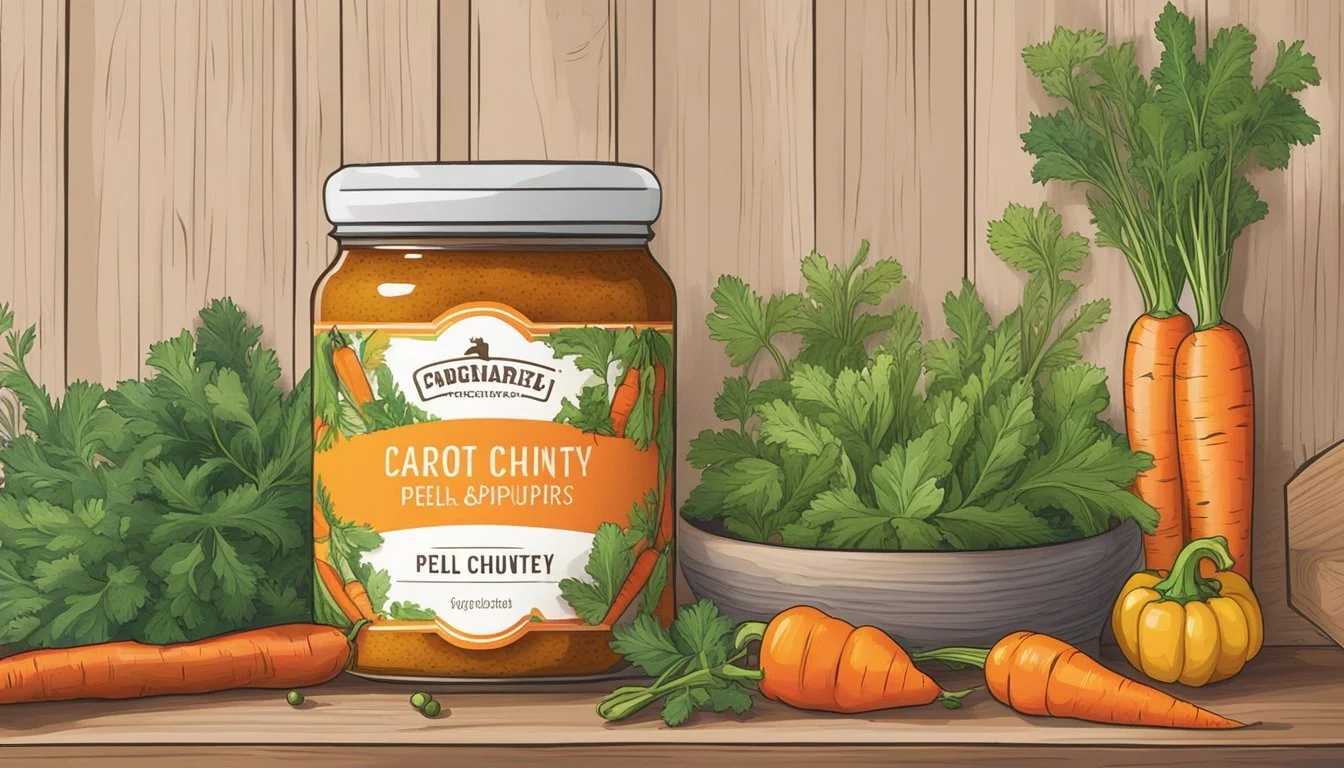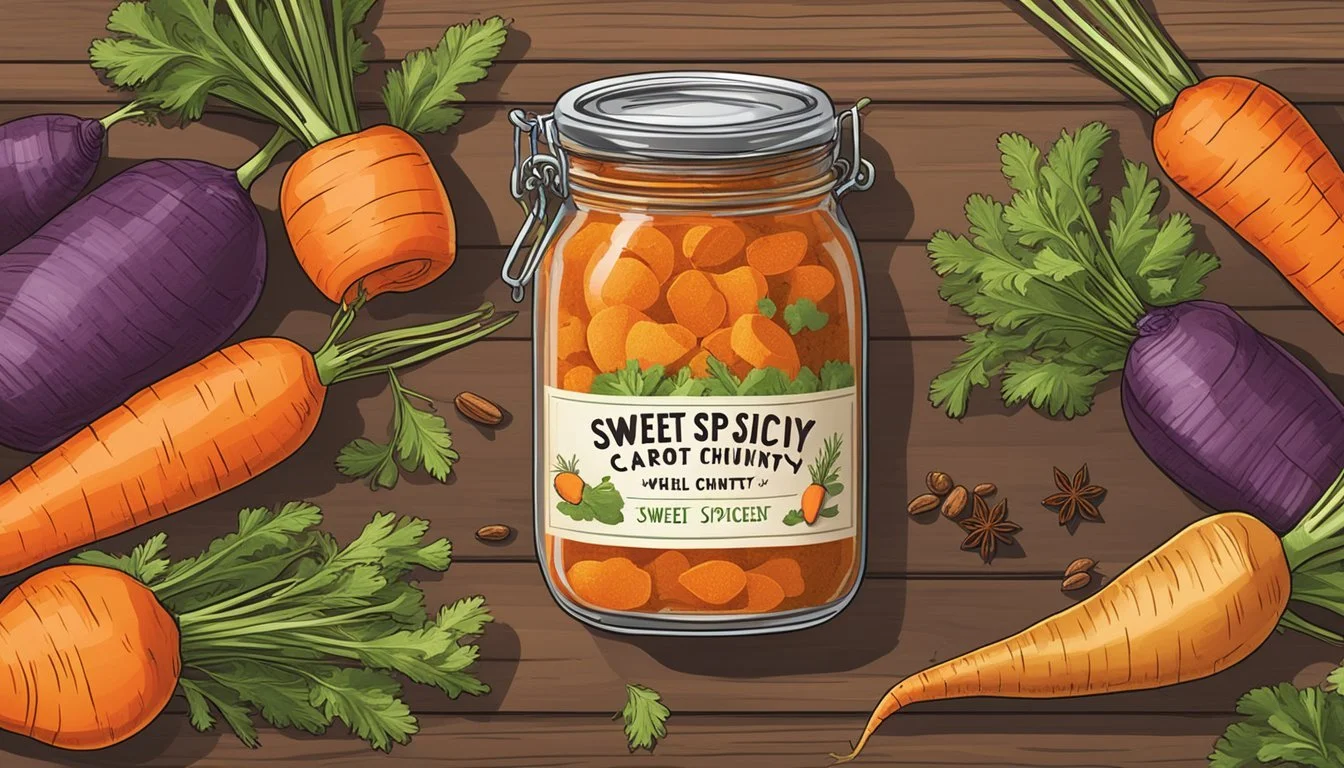Carrot Peel Chutney
A Sweet, Spicy Condiment Unveiled
Carrot Peel Chutney is a unique and flavorful condiment that elegantly transforms the oft-discarded peels of carrots into a culinary delight. This chutney aligns with the sustainable cooking philosophy, emphasizing the no-waste aspect of food preparation. Rich in nutrients, the peels are repurposed to create a condiment that is both sweet and spicy, offering an array of taste sensations that can elevate any meal.
Characterized by its vibrant color and a mixture of contrasting flavors, Carrot Peel Chutney combines the natural sweetness of carrots with the warmth of spices like ginger and cayenne pepper. The harmony of these flavors is further enhanced by the tang of vinegar and a subtle hint of garlic. These ingredients come together to produce a versatile chutney that pairs well with a variety of dishes, serving as a delectable spread, dip, or accompaniment.
Culinary adventures often seek to balance health with taste, and Carrot Peel Chutney succeeds in this endeavor. It not only utilizes ingredients that are readily available but also introduces a delightful way to incorporate more vegetables into one's diet. This chutney is easy to prepare and can be stored, allowing its complex flavors to meld over time, making it an enriching addition to any culinary collection.
Understanding Carrot Chutney
Carrot Chutney is a versatile condiment that complements a range of dishes, offering a balanced blend of sweetness, spice, and tang. It carries a remarkable nutritional profile and embodies a rich cultural heritage.
Origin and Cultural Significance
Carrot Chutney has its origins in Indian cuisine, where chutneys are staple companions to meals. Diverse in nature, chutney can range from sweet to spicy, with Carrot Chutney often striking a fine balance between the two. It is commonly served with curry, rice dishes, and bread like naan or dosa, acting as a burst of flavor to enhance the main course.
Nutritional Profile
Carrot Chutney is not only flavorful but also nutritious, as carrots are a healthy root vegetable. Below is a typical nutritional profile for a serving of Carrot Chutney:
Nutrient Amount per serving Calories Varied* Fat Low Saturated Fat Low Polyunsaturated Fat Low Monounsaturated Fat Low Sodium Moderate* Potassium Moderate* Carbohydrates Moderate Fiber High Protein Low Vitamins Rich in Vitamin A Antioxidants Present
*Specific amounts can vary based on the recipe and serving size.
Rich in fiber and antioxidants, notably beta-carotene (which the body converts to Vitamin A), Carrot Chutney can contribute to a healthy diet. It contains minimal amounts of fat and a moderate level of carbohydrates.
Flavor Profile
The flavor profile of Carrot Chutney is a careful harmony of sweetness derived from the natural sugars in carrots, the heat of spices like pepper and sometimes chili, and the tangy acidity from ingredients like vinegar or tamarind. Spices are tailored to enhance the taste without overpowering the inherent sweetness of carrots. Salt is used to balance the condiment's flavors, while sugar occasionally added can amplify the chutney’s tanginess. The result is a complementary condiment that adds a vibrant burst of flavor to various dishes.
Preparation Essentials
In the journey of crafting Carrot Peel Chutney, a perfect blend of sweet and spicy flavors, equipping oneself with the proper tools and selecting the finest ingredients are the cornerstones. A meticulous approach to these essentials ensures a delightful condiment outcome.
Kitchen Tools Needed
To begin, one requires a food processor or grinder to achieve a fine texture for the chutney. If neither is available, a mixer can serve as an alternative. Essential kitchen tools include:
Food Processor/Mixer/Grinder: For blending the ingredients to the desired consistency.
Knife: For chopping ingredients.
Saucepan: For cooking the chutney.
Measuring Cups and Spoons: For precise ingredient portioning.
Sterilized Jars: For storing the chutney.
Selecting Ingredients
For flavor and texture, fresh and high-quality ingredients are paramount:
Carrots: Fresh, preferably organic; the core component that should be washed and peeled.
Tamarind Paste/Jaggery: Sweetness balancers yielding the chutney's character.
Oil: A neutral one, such as vegetable or sunflower, to sauté the ingredients.
Mustard Seeds and Curry Leaves: Key for the chutney’s tempering, imparting a traditional Indian touch.
Coconut: Grated, offering a subtle sweetness and texture.
Onion, Garlic, and Ginger: Fresh, for the chutney’s aromatic base.
Tomatoes: Fresh and ripe; for adding a tangy note.
Salt: To taste, enhancing the natural flavors of the ingredients.
Making Carrot Chutney
Carrot chutney is a delightful blend of sweet and spicy flavors, which is simple to prepare. It pairs beautifully with various dishes, enhancing flavors with its tang and spice.
Step-by-Step Instructions
Prep Time: 10 minutes
Cook Time: 20 minutes
Prepare the Carrots: Start by peeling and chopping the carrots finely. This helps in reducing the overall cook time.
Simmer: In a pan, simmer the carrots with a small amount of water to soften them. One can add a dash of lemon juice to elevate the tanginess.
Temper the Spices: In a separate pan, heat oil and add mustard seeds, cumin seeds, coriander seeds, and if desired, cardamom pods. Once they crackle, add dry red chili or green chilies and a few cloves for an aromatic kick.
Blend: Once the carrots are soft and the spices tempered, transfer them to a blender. Blend to desired consistency, adding water as needed.
Adjust Seasoning: Taste the chutney and adjust salt and spices to suit your palate. If extra heat is desired, green chilies or chili powder can be included.
Recipe Variations and Substitutions
Chili Options: Swap green chilies for red chili flakes or powder to achieve varied levels of heat and color.
Sweetness Adjustments: Some recipes use jaggery or sugar. Adjust the quantity to balance the chutney's sweetness against its tang and spice.
Add Nuts: For texture and richness, add roasted cashews or peanuts to the blender.
A Touch of Coconut: Introduce grated coconut during the blending process for a creamier texture and subtle sweetness.
Tamarind Paste: An excellent way to introduce a distinct tang is to incorporate a spoonful of tamarind paste into the recipe before blending.
By following these instructions and making the suggested variations, one can craft a carrot chutney that will be a welcome addition to the serving table.
Serving Suggestions
Carrot peel chutney brings a versatile blend of sweetness and spice to the table, transforming ordinary dishes into gastronomic delights with just a spoonful.
Accompaniments
Idlis and Dosas: This chutney pairs perfectly with South Indian staples such as idlis and dosas, offering a zesty contrast to their neutral taste.
Dish Suggested Serving Idlis A dollop on the side Dosas A spread inside or aside
Sandwiches and Wraps: For a quick and unique twist, spread a thin layer inside sandwiches or wraps. The chutney's texture adds a burst of flavor that complements both vegetables and meats.
Meal Type Serving Recommendation Sandwiches Spread lightly on bread Wraps Mix with fillings
Presentation Tips
Cheese Platter: When served on a cheese platter, the chutney can be a delightful accompaniment, cutting through the richness of various cheeses with its tangy spice.
Cheese Type Presentation Suggestion Soft Cheeses (What wine goes well with soft cheeses?) Next to cheese, allowing guests to pair at their preference Hard Cheeses Drizzle over pieces for a melded taste experience
Texture and Flavor: Present the chutney in a small, elegant bowl or a saucer to maintain the texture and to let the burst of flavor stand out without overpowering the main dish.
Storage Recommendations
Proper storage of Carrot Peel Chutney is crucial for maintaining its freshness and flavor. This section provides specific guidance on preserving your chutney.
Preserving Freshness
To ensure the chutney remains fresh, one should store it in an airtight container. This limits exposure to air, preventing spoilage and oxidation. Storing the chutney in a refrigerator is optimal, considering a temperature range between 40°F (4°C) and 50°F (10°C). For fresh chutney that has not been opened, a cool dark place can also suffice, but once opened, refrigeration is essential to maintain quality.
Handling Leftovers
After serving, it's important to handle leftovers properly to extend their shelf life. Leftovers should be promptly returned to the refrigerator, ideally within two hours of serving. When preserved correctly, the chutney can last for up to a month, ensuring the maximum possible number of servings are not wasted. Usage of clean utensils when serving can prevent bacterial contamination, further securing the integrity of the remaining chutney.
Nutritional Information
Carrot peel chutney offers a melange of nutritional benefits, primarily from the carrots, which are a rich source of vitamins and antioxidants. This condiment provides a balance of flavor and health-promoting properties.
Health Benefits
Carrots are a powerhouse of vitamins such as Vitamin A, which is crucial for eye health. They are also laden with antioxidants that help in combating oxidative stress in the body. This chutney, being low in saturated fat and high in fiber, can be a healthy addition to a meal, particularly beneficial for heart health and digestion.
Vitamin A: Essential for good vision, immune system, and skin health.
Fiber: Aids in digestive health and may help control blood sugar levels.
Caloric Content Analysis
A serving of carrot peel chutney is relatively low in calories, making it a weight-friendly option when used in moderation. Carrots, the primary ingredient, contribute to the caloric content through their carbohydrates, but they also provide fiber which could aid in satiety. Minimal amounts of fat are usually present, depending on the recipe, but it's the type of fat to look out for - with a preference for monounsaturated and polyunsaturated fats.
Nutrient Amount per serving (approx.) Calories 45 kcal Total Fat 1g Saturated Fat 0.1g Polyunsaturated Fat 0.2g Monounsaturated Fat 0.7g Sodium 60mg Potassium 150mg Total Carbohydrates 10g Dietary Fiber 2g Sugars 6g Protein 1g
Further nutritional specifics would vary based on the additional ingredients and their proportions used in the chutney recipe.
Social Aspect
Carrot Peel Chutney is gaining traction as a versatile condiment that goes beyond its role as a simple side dish. Its vibrant appearance and unique taste have made it a popular topic of discussion on various social platforms and cultural gatherings.
Sharing on Social Media
Individuals take pride in crafting their own versions of Carrot Peel Chutney and often share their culinary creations on Instagram and other social media platforms. Photos and recipes are frequently posted, showcasing the chutney served with snacks, curry, or as a stand-alone treat. The visual appeal of this condiment, with its bright orange hue, invites likes and shares, making it a trending topic in foodie communities.
Chutney in Cuisine and Festivals
Chutney holds a significant place in culinary traditions and is often featured during festivals and communal feasts. Carrot Peel Chutney, with its sweet and spicy flavor profile, is enjoyed as an accompaniment to a variety of dishes. It elevates the experience of a meal by complementing both snacks and main courses, and its presence is notable in celebrations where food is a central element.
Final Thoughts
Carrot Peel Chutney is a vibrant and versatile condiment that brings life to a variety of dishes with its sweet and spicy flavor profile. This sustainable recipe embraces the "waste not, want not" philosophy, utilizing the often-discarded carrot peels and transforming them into a culinary delight.
Health Benefits: Carrot peels are rich in nutrients and antioxidants. Making chutney from these peels not only reduces waste but also offers a healthful option for those looking to add more vegetables to their diet.
Flavorful Addition: The chutney's sweetness from the carrots pairs wonderfully with the spiciness of added ingredients like cayenne pepper or red chili flakes, offering a balanced taste that complements everything from rice to sandwiches.
Given its easy-to-prepare nature, Carrot Peel Chutney is not time-consuming. One can quickly create this condiment with minimal ingredients, most of which are staples in the average kitchen. It encourages home cooks to look at food scraps in a new light, discovering the potential in all parts of their produce.
They will find that the chutney's robust flavors enhance meals while contributing nutritional value. It's a testament to the beauty of simplicity in the kitchen and the joy of creating something delicious and healthy from what would otherwise be discarded. This condiment stands as a prime example of eco-conscious cooking without compromising on taste or quality.






